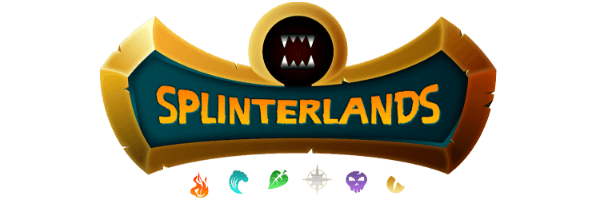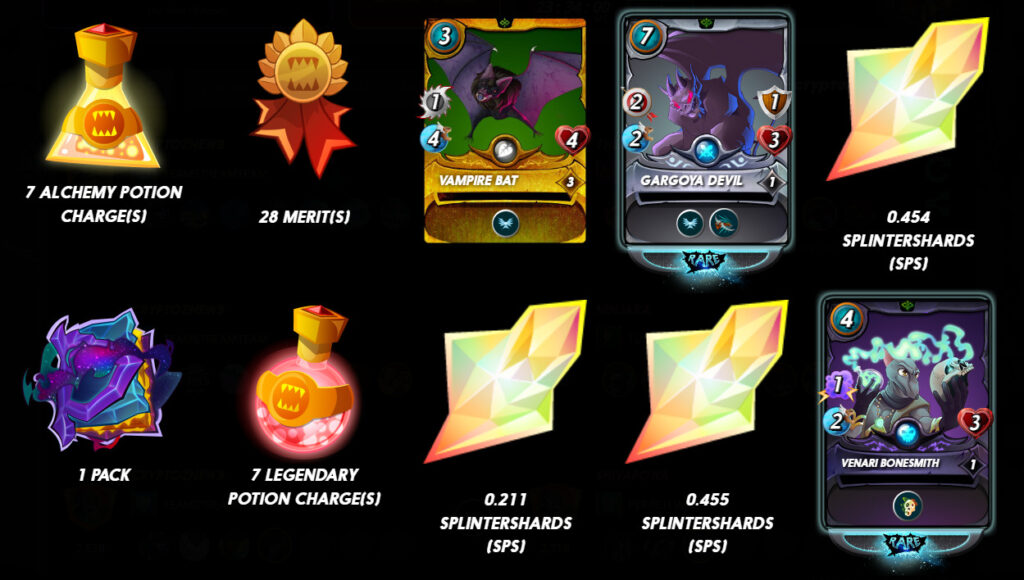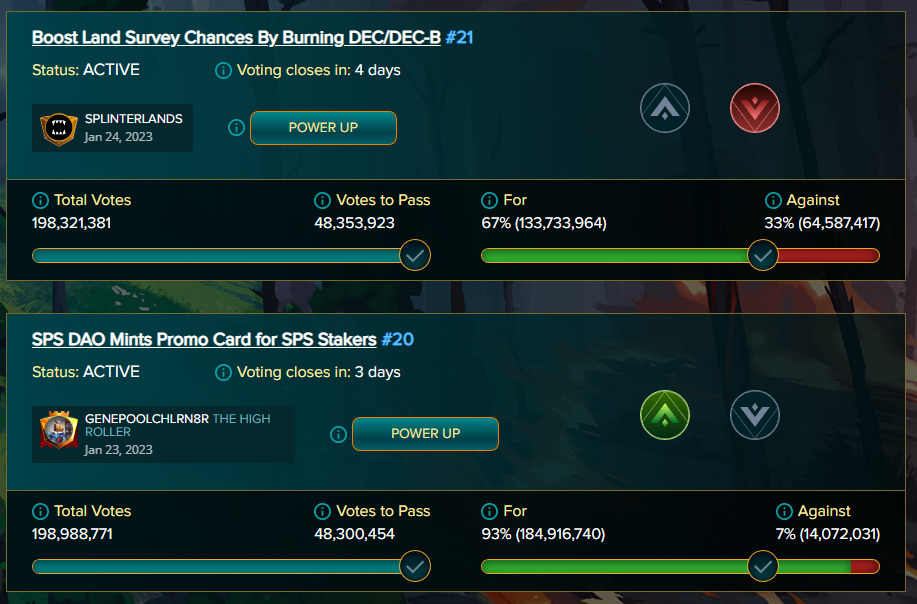Splinterlands Overview
Originally built on the Steem blockchain, Splinterlands moved to Hive after the fork from Steem in 2020. Though not completely free to play, Splinterlands has a low entry point and offers play to earn opportunities relatively quickly for active players.
Read on in this game guide to learn the Splinterlands basics, some info about their tokens, and how you can play and earn in this collectible card game / auto-battler
Splinterlands Review
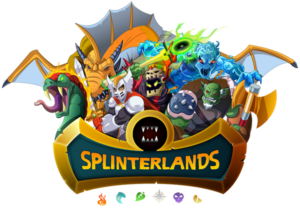 Splinterlands is an auto-battler card game where every card is a collectible NFT. Built on the Hive blockchain, Splinterlands features daily quests, seasonal rewards every two weeks, guilds, a tournament system, and an in-game marketplace that includes secure card rentals! This guide will help you get started with this web3 enabled game.
Splinterlands is an auto-battler card game where every card is a collectible NFT. Built on the Hive blockchain, Splinterlands features daily quests, seasonal rewards every two weeks, guilds, a tournament system, and an in-game marketplace that includes secure card rentals! This guide will help you get started with this web3 enabled game.
Players can earn card and token rewards just by playing. Land gameplay is expected to arrive in 2023.
Splinterlands Gameplay Overview

In Splinterlands, players face off in one on one battles. For the match, each player selects a summoner, and then chooses a selection of creatures that are either neutral or that belong to the same element as the summoner. IE, Water Summoners can use Water Creatures and Neutral Creatures.
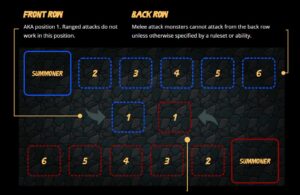
Summoners and Monsters have an associated Mana cost associated and every battle has a limit on the amount of Mana available. This can range from as low as 11 all the way up to 99! Also, at the higher ranks, battles come with up to three special rules. These rules are many. Some examples are, only melee attack can be used, every Monster starts the battle poisoned, or no Monsters with Magic attack can be used. These rules provide variation from match to match and force players to think strategically about every fight.
Once a battle begins, it’s all resolved automatically. However, choosing cards that work well together and that hopefully counter your opponent is not a simple task.
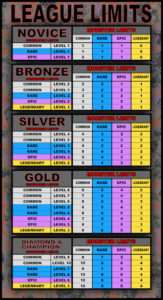
Positioning matters, as most creatures only attack the enemy card in the front position. Cards with Melee attack can only attack from the first position. Ranged can only attack when NOT in the first position and Magic creatures can attack from anywhere, as well as ignore armor.
Most Summoners provide some sort of bonus or opponent debuff. Many Monsters have abilities as well. In fact, there are a several dozen different abilities! Some effect that card only, while others are team buffs, or enemy debuffs. Examples include Sneak (attack enemy Creature in the back), Reflection (return half of magic damage received back to the attacker), and Bloodlust (gain stats whenever this creature gets a kill). Some Monsters even have multiple Abilities, especially at higher levels!
Players receive a set of free, account bound cards to use when they first start playing.
Leveling Up cards
Splinterlands features an interesting mechanic allowing cards to level up. This is done by combining multiple copies of the same card. As Monsters level up, they gain stats and abilities, which can often make a difference in battle. The number of cards required for combining increases with each level. Commons max out at level 10, Rares at 8, Epics at 6, and Legendary cards at level 4.
This feature not only provides additional incentive for players to continue purchasing packs, but it also creates an eternal, deflationary mechanism for cards once their print run completes. Every time someone combines cards, those extra cards are burned and the total supply for that card decreases!
But perhaps more important than Monsters leveling up, are Summoners leveling up. Summoner levels limit the Monster level you can use. For example, level 1 Rare Summoners can only use Monsters of level 1 and can’t use Legendary cards at all!
Each league also has limits on the maximum level of Summoner that can be used. You can still use cards that are higher level, but their stats will be auto de-ranked to match the maximum allowed level for the fight.
Splinterlands Play-to-Earn Mechanics
Splinterlands boasts a strong economy, with daily and seasonal rewards, an in-game rental system, leaderboards, and tournaments (also with rewards) for those who like an extra challenge.
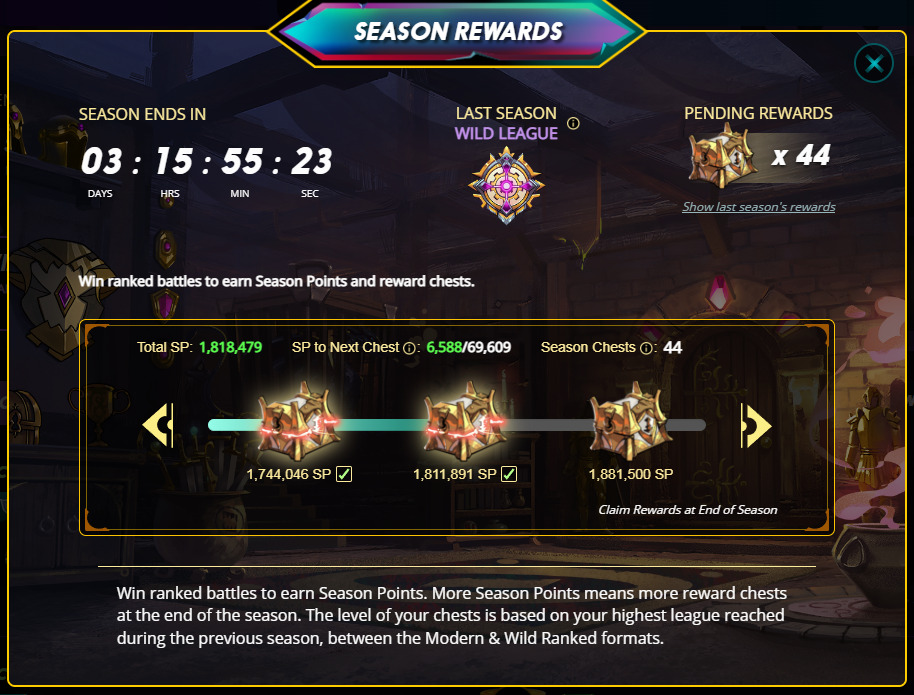
Initial Investment
Splinterlands is technically free to play, though to earn rewards, you must purchase a Summoner’s Spellbook for $10. This Spellbook is not an NFT and is not tradeable. It is an upgrade to your account allowing you to access all facets of Splinterlands.
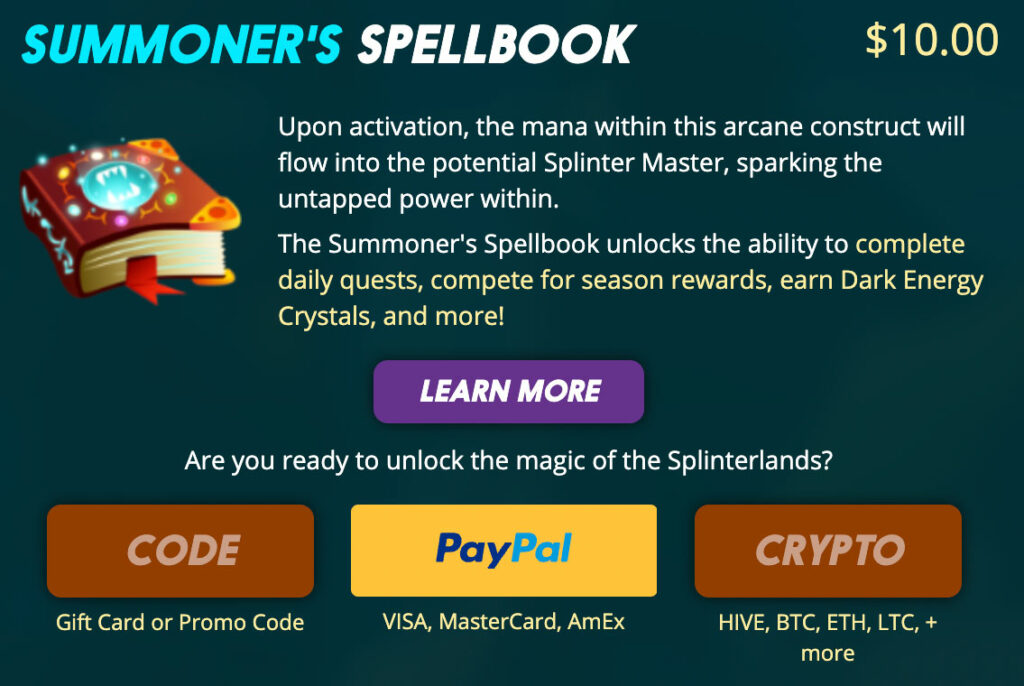
Splinterlands Rewards System
Players receive a reward of Splintershards tokens with every match they win along with Ranking points. There are also daily quests, and end of season rewards. The number of rewards chests received depends on the number of Ranking points accumulated. Reward chests can contain reward cards, SPS tokens, Merits (used to purchase Gladiator packs), Potions, and sometimes even card packs!
Potions come in two flavors, Legendary and Alchemy. These increase your odds of finding a Legendary or Gold Foil card respectively. Potions only work when opening card packs, though, not reward chests.
The game features a built-in tournament system. Weekly tournaments are hosted by the Splinterlands team, though there are many more run by the community. Everything is handled via the in-game interface. No need for tracking the tournament on a secondary website. Players can also join Guilds, allowing them to participate in twice weekly team competitions against other Guilds for Guild-related rewards and SPS tokens.
Cards and card packs can be sold or traded. In addition to the standard reward chests, the top 30 players in each Tier receive a bonus payment of SPS tokens at the end of a season.
Beginning on January 31st, 2023, reward cards are account bound until until that particular reward set goes out of print. Duplicates can still be merged to level up the cards.
Splinterlands Tokens
Splinterlands features two main tokens — DEC (Dark Energy Crystals) and SPS (Splintershards), a ‘Voucher’ token, and a stablecoin called Credits. The only way to buy packs and potions in-game is with Credits or DEC. Luckily, Splinterlands features a swap mechanism, allowing players to easily acquire Credits with Paypal or a number of different cryptocurrencies. Players can get DEC by burning Splinterlands cards or exchanging SPS tokens.
Dark Energy Crystals (DEC) are the game currency used for buying, selling, and renting cards.
Splintershards (SPS) are the game’s governance token and also used for almost everything in the ecosystem. They are used to buy new packs and other Splinterlands items, burned to make new DEC tokens, and will likely be an important part of land gameplay. Players can also stake SPS tokens to vote on game proposals via an in-game interface.
Vouchers only exist on the Hive blockchain and are used for special events and promotions. Owners of staked SPS and Splinterlands licenses receive daily airdrops of VOUCHERS. These have previously been required for early purchase of Chaos Legion packs and the recent Waka Spiritblade promotion.
All of these can be traded on Hive-Engine market. SPS and DEC tokens can also be transferred between other blockchains such as Ethereum and Binance Chain.
How to Get Started in Splinterlands
The game provides a basic set of level 1 cards that you can use, though don’t own. These include Summoners and Creatures. The game also features a short tutorial, which new players should follow to learn the basics. After that, the best way to learn is just to dive in and try out different Summoners and card combinations.
Splinterlands does require a Hive account. Luckily, they are free to create and the Hive Keychain app works well for logging in and handling transactions. If you don’t have an account, Splinterlands helps get one setup when you purchase a Spellbook.
Tips for Playing Splinterlands
Summoners are often the gateway to reaching higher rank. Rent higher level ones as needed. Pick two or three to focus on if you’re building up your own set of cards.
Experiment. Don’t always just put in the highest value cards. Oftentimes, having a specific focus is better. Healing can make a huge difference. Don’t neglect adding a healer if none of your Monsters self-heal.
Look at the upgrades for your cards and decide which ones you like best. Sell or rent cards you don’t use. Upgrade cards that you use often.
Explore the rental market. It is entirely possible to rent a selection of cards that can carry you to higher ranks. If you’re willing to spend some time getting used to the more advanced interface, PeakMonsters is a great source for finding deals and seeing a better overview of the market.
Once you have an understanding of the game mechanics, be sure to check your opponent’s recent match history before you start your team selection. You can do this by mousing over their battle history icons at the top of the start match screen. Oftentimes, noticing a pattern in their playstyle can provide a significant advantage!
Work your way up. Bronze ranks don’t give out meaningful rewards. A few Credits won’t get you far. But once you reach Silver ranks, the rewards switch from Credits to SPS and you start receiving more cards. This means more battle options, a chance to level up duplicate cards for even stronger teams.
Steady, daily play works better than marathon sessions. Each player has a ‘ Capture Rate’ factor that affects the amount of SPS and Ranking points they earn from winning matches. Each match lowers the rate, which regains slowly over time.
Splinterlands Review
 The game can seem bit boring at the start. Especially with limited card selections and the hands-off battle simulation. But once you have more cards to play with and reach the ranks where battles have special rules, the game becomes much more engaging.
The game can seem bit boring at the start. Especially with limited card selections and the hands-off battle simulation. But once you have more cards to play with and reach the ranks where battles have special rules, the game becomes much more engaging.
As a player, you can approach this as a play-to-earn game or a play-and-earn game, depending on how much you want to grind out matches. But even if you’re just a casual player, don’t miss out on the chance to rent out cards for passive income or hold them for the SPS airdrop!
In some ways, the game is pay to win. Having higher level creatures can make a huge difference in regards to the match results. Winning more equates to more rewards and higher ranks and even more rewards! But the rental market does a lot to equalize that imbalance. It is very possible to rent your way to the top of the lower tier leaderboards while building up your own collection.
Splinterlands is in the process of adding lands gameplay to their game. Landowners can currently claim land plots, with more features expected soon. They are also planning on adding a distributed game system via Licenses in the future.
The team holds weekly Town Hall meetings with updates, news, and questions from the audience.

